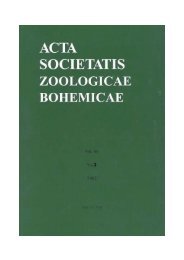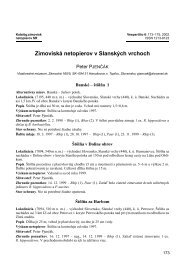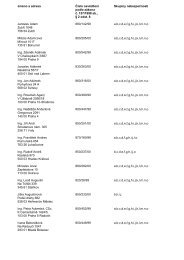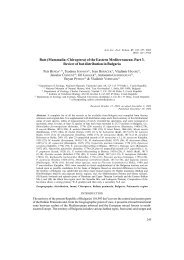You also want an ePaper? Increase the reach of your titles
YUMPU automatically turns print PDFs into web optimized ePapers that Google loves.
Arthropods of Burgess Shale type from the Middle Cambrian of Bohemia (Czech Republic)Measurements: The best-preserved specimen(L36596) shows the dorsoventral width of the valve as21.5 mm, its length being 23 mm. The maximum diametersof other specimens range between 30 and 17 mm.The smallest specimen SZ168 is 15.8 mm in diameter atthe most.Remarks. As the extremities and the thorax remainunknown, the interpretation and assignment are doubtful.The rounded outline and smooth surface of carapacevalves are shared with several Cambrian arthropod taxa ofdiverse relationships. Most morphologically similar arecarapace valves of the genera Forfexicaris Hou, 1999, OccacarisHou, 1999, and Clypecaris Hou, 1999, all from theLower Cambrian Chengjiang fauna (Hou 1999). Amongthem, Forfexicaris seems to show greatest analogy inavailable features, and, therefore, the remnants are tentativelyassigned to it with reserve.Though the flattening cannot be excluded in all specimensso far collected, the absence of any marked coarseand irregular wrinkles on the evidently very thin cuticlepoints to the valves being originally flat in life.The described fossils were previously figured fromthe Jince Formation of the Jince area by Mergl and Šlehoferová(1991, pl. 11, figs 4, 5, MM284, YA1305), whoclassified them with reserve as brachial valves of a possiblebut doubtful inarticulate brachiopod Acrothele giganteaŽelízko of uncertain systematic position (evenwith possibility of exclusion from Brachiopoda).Mikuláš (2000) in his revision of Bohemian MiddleCambrian ichnofossils figured in pl. 13, figs 3, 4 and pl.34, figs 6, 7 also subcircular very thin valves, which healso regarded with some reserve as shells of inarticulatebrachiopods with superficial ichnofossils designated asfodinichnion igen. et isp. indet.These subcircular thin shells are best interpreted asarthropod carapace valves designated here as Forfexicaris?sp. Almost all show also analogous trace fossils ontheir surface – possibly traces of scavengers (the relationshipsbetween arthropod remnants and associatedichnofossils will be discussed elsewhere). However, therocks of the Jince Formation also contain thicker-shelledsubcircular fossils with indicated apices whose brachiopod(inarticulate) nature is very probable – this concernse.g. some specimens designated as Acrothele giganteaŽelízko deposited in collections of the National Museum,Prague.The described thin-shelled subcircular fossils probablydo not occur so sporadically as the available materialsuggests. Their unattractive nature probably meantthat they were in most cases overlooked by fossil collectors,even at classic localities.Occurrence: Jince Formation, Jince area: the slopeof Vinice, Paradoxides gracilis Zone, Rejkovice (railwaycutting) and Koníček near Jince, the Ellipsocephalus hoffi– Rejkocephalus Zone, Skryje-Týřovice area: Luh andPlazy near Skryje, Eccaparadoxides pusillus Zone.Biostratigraphy and accompanying faunaThe Jince Formation, introduced in the literature byLipold and Krejčí (1860) for Barrande’s étage C of his“Silurian System” (1852) and later moderately redefined(Havlíček in Chlupáč, ed. 1968), corresponds too much ofthe Middle Cambrian.According to recent state of knowledge, it can be subdividedinto several biostratigraphic zones and subzones(“horizons”); see Fatka and Kordule (1992), Kordule(1996), Fatka (2000). The distribution and character offaunas clearly reflect the cycle of marine ingression, startingwith low-diversity brachiopod and trilobite-dominatedassemblages and continuing over two maxima of abundancedistinguished by the presence of higher diversityfaunas (even with miomerid = agnostid trilobites) and declininginto the regressive phase in the uppermost part ofthe Jince Formation with dominating lingulids.The finds of described non-trilobite arthropods belongmostly to the upper parts of the Jince Formation, i.e. withinthe sequence with common trilobite and other faunas.The occurrence of Tuzoia sp., however, does not fullycorrespond with the abundance and diversity maxima ofother fossils. The oldest find derives from the upper part ofthe Eccaparadoxides pusillus Zone. Most remains, however,come from the interval between the E. pusillus andParadoxides gracilis Zones, particularly from its upperpart (designated by Kordule 1996 as the Subzone withAcanthocystites and Akadocrinus), where also Proboscicarishospes was found, but the total faunal diversity islow. The common accompanying trilobite is here Hydrocephalusminor (Boeck), frequently found even as completeexoskeletons. It is joined by Rejkocephalusrotundatus (Barrande), Peronopsis integra (Beyrich),Acanthocystites briareus Barrande, Akadocrinus janiProkop, Stromatocystites pentangularis Pompeckj, rareKonicekion radion Šnajdr, and very few other fossils. Accordingto Mikuláš (2000), Planolites and Teichichnusdominate among ichnofossils.Rare remains of Tuzoia sp., carapace valves of Forfexicaris?sp. and the unique find of the large tuzoiidarthropod (Tuzoidae n. gen.?), as described here, werefound within the upper part of the Jince Formation withthe second maximum fossil abundance, namely in theParadoxides gracilis Zone. They occur together with numeroustrilobites with strongly dominant Paradoxidesgracilis (Boeck), frequent Conocoryphe sulzeri(Schlotheim), Ptychoparia striata (Emmrich), Hydrocephalusminor (Boeck), Peronopsis integra (Barrande),echinoderms Lichenoides priscus Barrande, Stromatocystitessp., Etoctenocystis bohemica Fatka et Kordule,rare ostracods Konicekion radion Šnajdr, hyolithids,Tommotium sp. etc.In the present zonal subdivision of the Middle Cambrianaccording to agnostid trilobites, the above mentionedbeds with arthropod remains can be roughly correlated177








